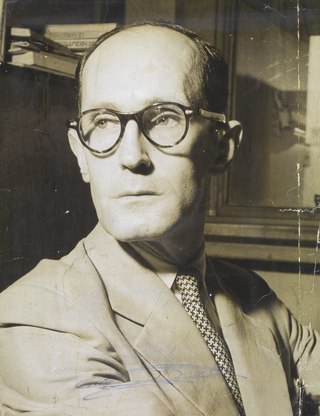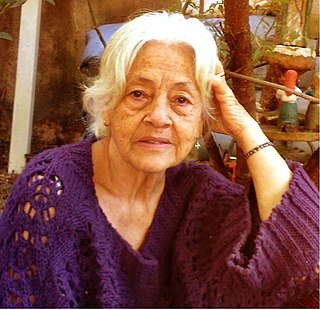
Tarsila de Aguiar do Amaral was a Brazilian painter, draftswoman, and translator. She is considered one of the leading Latin American modernist artists, and is regarded as the painter who best achieved Brazilian aspirations for nationalistic expression in a modern style. As a member of the Grupo dos Cinco, Tarsila is also considered a major influence in the modern art movement in Brazil, alongside Anita Malfatti, Menotti Del Picchia, Mário de Andrade, and Oswald de Andrade. She was instrumental in the formation of the aesthetic movement, Antropofagia (1928–1929); in fact, Tarsila was the one with her celebrated painting, Abaporu, who inspired Oswald de Andrade's famous Manifesto Antropófago.

Brazilian literature is the literature written in the Portuguese language by Brazilians or in Brazil, including works written prior to the country's independence in 1822. Throughout its early years, literature from Brazil followed the literary trends of Portugal, gradually shifting to a different and authentic writing style in the course of the 19th and 20th centuries, in the search for truly Brazilian themes and use of Brazilian forms.

Carlos Drummond de Andrade was a Brazilian poet and writer, considered by some as the greatest Brazilian poet of all time.

Manuel Carneiro de Sousa Bandeira Filho was a Brazilian poet, literary critic, and translator, who wrote over 20 books of poetry and prose.

José Oswald de Souza Andrade was a Brazilian poet, novelist and cultural critic. He was born in, spent most of his life in, and died in São Paulo.

Henriqueta Lisboa (1901–1985) was a Brazilian writer. She was awarded the Prêmio Machado de Assis for her lifetime achievement by the Brazilian Academy of Letters. She is famous for her well-chosen words to create powerful poems. Her early lyrics deal with traditional poetic themes, while her later poems like Echo, she mysteriously magnifies the effect of a single image.

Adélia Luzia Prado Freitas is a Brazilian writer and poet.

Paulo Leminski Filho was a Brazilian writer, poet, translator, journalist, advertising professional, songwriter, literary critic, biographer, teacher and judoka. He was noted for his avant-garde work, an experimental novel and poetry inspired in concrete poetry, as well as abundant short lyrics derived from haiku and related forms. He had a remarkable poetry, as he invented his own way of writing, with puns, jokes with popular sayings and the influence of haiku, in addition to abusing slangs and profanity.
Frederico Barbosa is a Brazilian poet.

Vicente do Rego Monteiro, born in Recife, was a Brazilian painter, sculptor, and poet, born to a rich family. He was part of the Semana de Arte Moderna exhibition and helped form the later Brazilian Modernism.
Corsino António Fortes was a Cape Verdean writer, poet and diplomat. He served as the first Ambassador of Cape Verde to Portugal from 1975 until 1981 following his country's independence.
The Anthropophagic Manifesto, also variously translated as the Cannibal Manifesto or the Cannibalist Manifesto, was published in 1928 by the Brazilian poet and polemicist Oswald de Andrade, a key figure in the cultural movement of Brazilian Modernism and contributor to the publication Revista de Antropofagia. It was inspired by "Abaporu," a painting by Tarsila do Amaral, modernist artist and wife of Oswald de Andrade. The essay was translated to English in 1991 by Leslie Bary;

Luis Carlos Verzoni Nejar, better known as Carlos Nejar, is a Brazilian poet, author, translator and critic, and a member of the Academia Brasileira de Letras. One of the most important poets of its generation, Nejar, also called "o poeta do pampa brasileiro", is distinguished for his use of an extensive vocabulary, alliteration, and pandeism. His first book, Sélesis, was published in 1960.
Manoel Wenceslau Leite de Barros was a Brazilian poet. He won many awards for his work, including twice the Prêmio Jabuti, the most important literary award in Brazil.
Beatriz Francisca de Assis Brandão was a Neoclassical or Arcadian Brazilian poet, translator, musician, educator and early feminist. One of the few prominent female intellectuals and artists in Brazil during the reign of Pedro II, she became well-known for her poetry, frequently published in Brazilian newspapers. Through her life and work, she challenged the dominant societal roles for women at the time and played an important part in Brazilian social, political and cultural history.

Silviano Santiago is a Brazilian writer, literary critic, essayist and scholar.

Delfina Benigna da Cunha (1791–1857) was a Brazilian poet. Her works reflected the increasing socio-political participation of Brazilian women through literary and journalistic production. da Cunha explored gender as well as imperial and national identities. She is also cited as a leading figure in the development of Gaucho literature.

Lupe Cotrim or Lupe Cotrim Garaude was a Brazilian poet and university professor.

Modernism in Brazil was a broad cultural movement that strongly affected the art scene and Brazilian society in the first half of the 20th century, especially in the fields of literature and the plastic arts. It was inspired by the cultural and artistic trends launched in Europe in the period before the World War I such as Cubism, Futurism, Expressionism and Surrealism. These new modern languages brought by the European artistic and literary movements were gradually assimilated into the Brazilian artistic context, but with elements of the country's culture, as there was a need to valorize the national identity.

The anthropophagic movement was a Brazilian artistic manifestation of the 1920s founded and theorized by the poet Oswald de Andrade and the painter Tarsila do Amaral.














